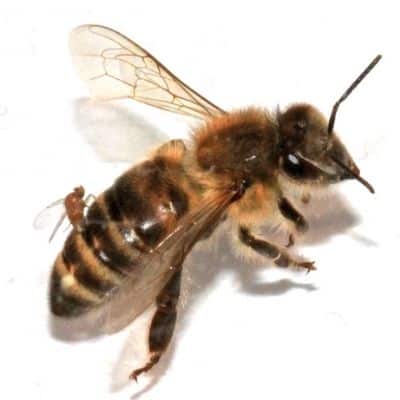 |
Re: California High Speed Rail: a Zombie Agency? What are Zombee Bees?
Author: Apocephalus borealis
Date: 01-06-2024 - 15:23

What are Zombee Bees?
Every time we think we have a “pretty good bead” on beekeeping, something else comes along. Isn’t that the way things go? It does seem that we are constantly hearing about some new pest or disease that threatens our hives.
So, when we see very “un-bee-like” behavior in our colonies, one of our first thoughts is – now what?
This is the reaction of beekeepers when a strange behavior was discussed that involved zombie behavior in honey bees. No – it is not a joke.
Zombee bees is the term being used to describe honey bees that are infected by a parasitic fly-Apocephalus borealis. This infection is causing some really unusual bee activity.
Dead honey bee with zombie headstone image.
Symptoms of Infected Bees
The problem was first noted in California around 2008. A bug loving biologist, John Hufernik, became aware of strange honey bee behavior.
He was finding dozens of dead honey bees near outside lights each morning. Seeing some bees below an outside light is no surprise but the number of dead were concerning.
Even more puzzling, this was happening even on cool frosty mornings. And, we know that honey bees are insects – being cold blooded they are not normally out in cold temps.
Honey Bees Don’t Normally Fly at Night
Honey bees travel towards light – it attracts them. But, it is unusual for bees to fly at night. Other than some sightings of foraging on full moon nights in warm weather -most foragers stay home during the dark hours.
Because bees use UV and polarized light to navigate, their tracking systems do not function well in the dark.
Of course, bees will leave the hive if disturbed by a predator after dark. This is why you don’t want to be the one holding the flashlight when moving bee hives at night! (They are not attracted to red light though so that is a good substitute.)
Leave the Hive Never to Return
West Coast researchers and beekeepers noticed honey bees leaving the hive to gather at nearby lights. Not the total population of the colony, but many individuals would leave.
After flying to a visible light source (even if it was not in the close to the hive), the bees would buzz around the light until they died.
There were reports of disoriented dying bees crawling on the ground under the light at dawn. Somewhat like a “zombie that staggers around after dark – never to return to their home”. This is where the term “Zombee Bees” originated.
Infected bees may show disorientation, walk in circles or have the inability to stand.
Graphic listing the possible symptoms of honey bees infected by Apocephalus borealis.
What is Apocephalus borealis?
Does this mean you will see thousands of freaked out bees flying around at night? Before you go running to grab a silver bullet, wooden cross or garlic necklace, let me explain a bit more.
Apocephalus borealis is a parasitic fly and it is not a newcomer to the United States. In fact, it is native to most of North America.
Smaller than a fruit fly, it was previously known to prey on bumble bees. Honey bees have not been a known host in the past.
Now, we know they are infecting honey bees. Has this been going on for a long time or is it a new development? We do not know.
Parasitic Fly Life Cycle
The cycle begins when an adult female fly lands on the back of an adult honey bee. She sticks her ovipositor (egg-tube) into the abdomen of the bee. Eggs are deposited inside the body of the bee where they hatch into larvae.
Fly larva feed over a period of about 7 days. Organs and tissues of the honey bee are consumed by the developing fly larva. Naturally, the health of the infected bee continues to deteriorate.
In the later stages of infection, the host honey bee becomes increasingly agitated. She is also attracted to light at night and will fly from the hive. (We don’t know why.)
The bee will hover around the light until she dies. Therefore, you may find a file of dead bees at the base of a lamp post.
When the fly larvae have completed their growth cycle, they will leave the bee’s body and pupate elsewhere for about 28 days. Up to 15 fly larvae may emerge from a single honey bee!
Then, the new adult flies begin the cycle.
[url=http://[carolinahoneybees.com]]https://carolinahoneybees.com/zombie-bees-what-you-need-to-know[/url]
| Subject | Written By | Date/Time (PST) |
|---|---|---|
|
|
Commenter | 01-05-2024 - 19:37 |
|
|
BOB2 | 01-06-2024 - 09:25 |
|
|
Night of the living dead | 01-06-2024 - 13:09 |
|
|
Apocephalus borealis | 01-06-2024 - 15:23 |